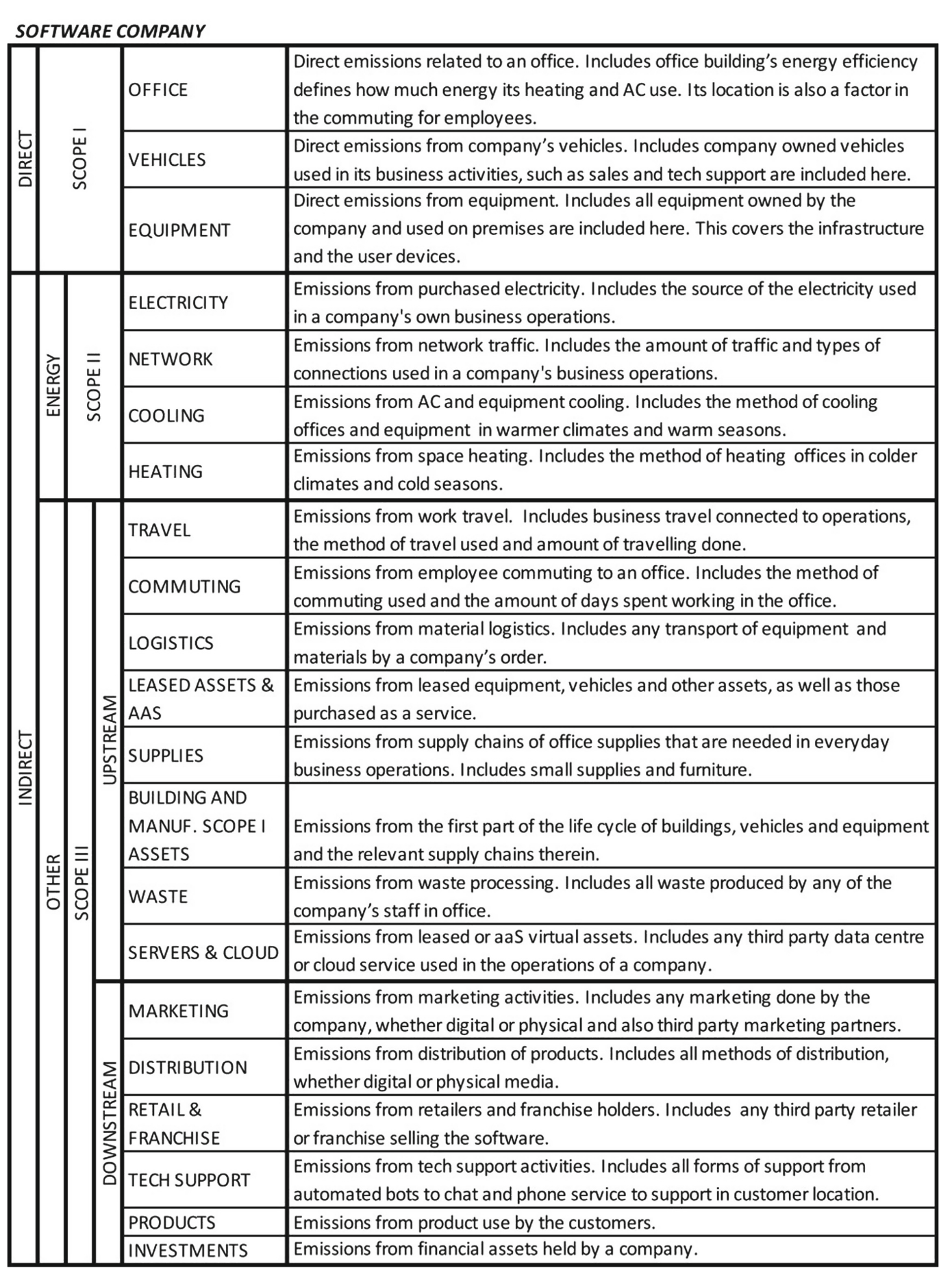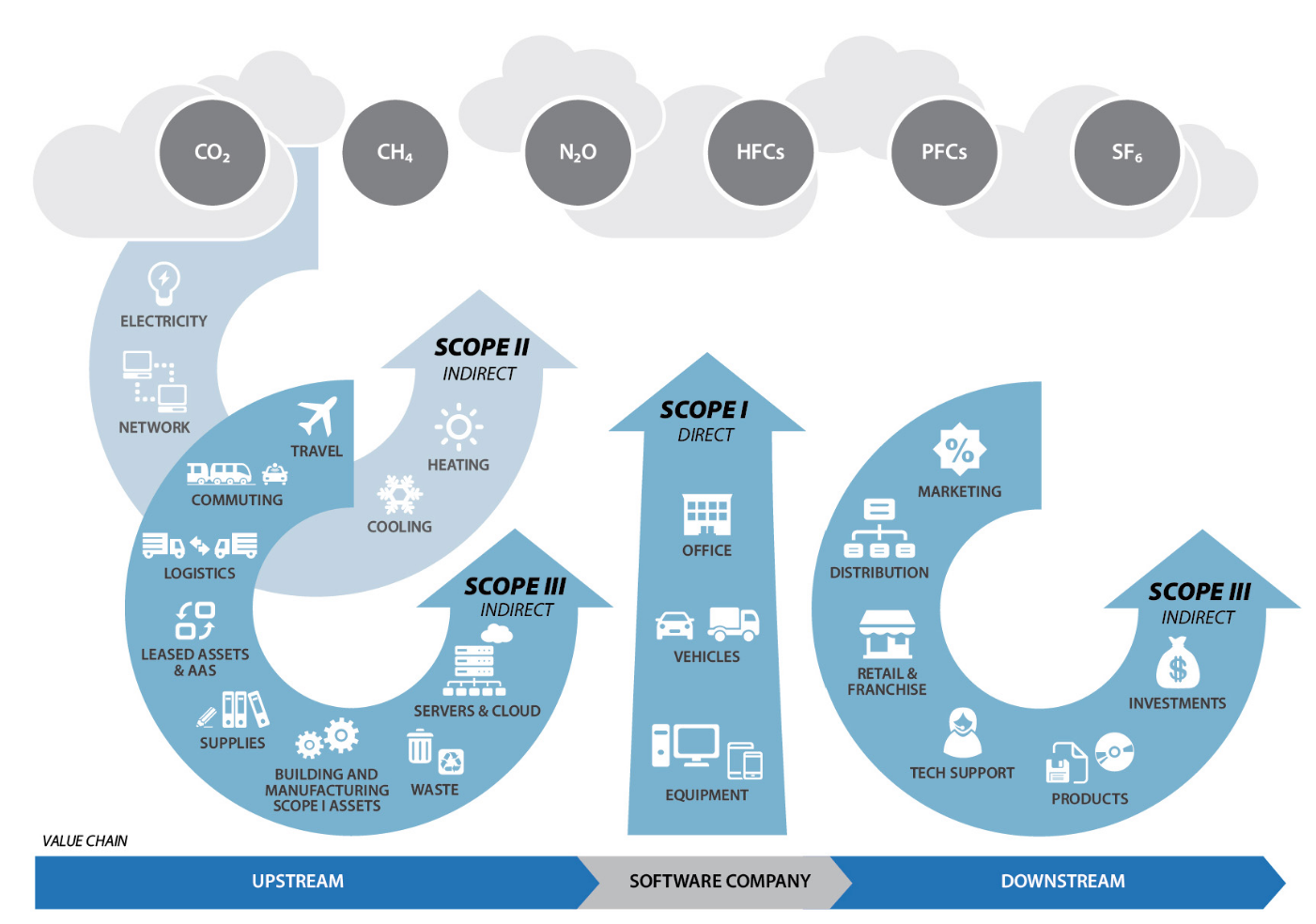Carbon Footprint Calculations for a Software Company – Adapting GHG Protocol Scopes 1, 2 and 3 to the Software Industry
Status:: 🟩
Links:: Accounting of GHG Emissions from Digital Services & Companies
Metadata
Authors:: Sipilä, Antti; Partanen, Laura; Porras, Jari
Authors:: Hyrynsalmi, Sami; Münch, Jürgen; Smolander, Kari; Melegati, Jorge
Title:: Carbon Footprint Calculations for a Software Company – Adapting GHG Protocol Scopes 1, 2 and 3 to the Software Industry
Date:: 2024
Publisher:: Springer Nature Switzerland
URL::
DOI:: 10.1007/978-3-031-53227-6_31
Sipilä, A., Partanen, L., & Porras, J. (2024). Carbon Footprint Calculations for a Software Company – Adapting GHG Protocol Scopes 1, 2 and 3 to the Software Industry. In S. Hyrynsalmi, J. Münch, K. Smolander, & J. Melegati (Eds.), Software Business (pp. 442–455). Springer Nature Switzerland. https://doi.org/10.1007/978-3-031-53227-6_31
Through non-financial reporting, such as CSRD, carbon footprint calculations are becoming mandatory in the software industry. The golden standard for reporting CO2 emissions is based on the Greenhouse Gas (GHG) Protocol and its scopes 1, 2, and 3. However, as a producer of purely digital products, the software industry differs from traditional industries in its carbon footprint. The software industry value chain relies heavily on an infrastructure that can contribute most of its emissions. It has been recognized that there is a need for an industry-customized carbon emissions model that considers the software industry's peculiarities. The primary goal of this study is to define the main sources of climate impacts in the software industry and propose a model of the GHG Protocol adaptation to software companies. This research has been done in our Green ICT project and is based on interviews done in that project. The data for this research was collected from five software companies with different demographics and business models. The interviews, with a total amount of 14, were conducted between November 2022 and March 2023 during a service design process of an automated tool that facilitates green transition in software companies. The analysis of the interviews was supplemented with the results from four multi-stakeholder workshops conducted during the service design process, as well as with the analysis of a series of webinars around the topic. As a result of the study, the Software Company Scopes model for the primary sources of greenhouse gas emissions in the software company and its value chain was created, and the GHG Protocol was tailored to the needs of the software industry. Thus, considering its industry-specific peculiarities, we may conclude that the GHG Protocol can be applied to the software industry.
Notes & Annotations
Color-coded highlighting system used for annotations
📑 Annotations (imported on 2024-03-17#07:17:44)
Adopting the GHG Protocol for specific industries requires identifying the relevant business operations and their effects. Software companies are a special case in this regard, as their products are digital instead of physical. On the other hand, these products are dependent on physical hardware infrastructure, which means they require electricity and thus produce emissions [9]. In addition, modern software uses a client-server model, which runs on a server in a data center environment or a cloud service. This affects the emissions and makes the emissions calculation fuzzy.
The first step, design, is the phase where most of the critical decisions concerning the emissions are made [13]. These include architecture choices [17, 18], programming language [19–21], integrated development environment, graphical choices [22], etc. These choices influence both the coding and testing phase and the usage and maintenance phase. As such, it seems to influence many of the scope three emissions in both the downstream and upstream.
- Shenoy, S.S., Eeratta, R.: Green software development model: an approach towards sustainable software development. In: 2011 Annual IEEE India Conference, pp. 1–6. IEEE (2011)
- Jagroep, E., van der Werf, J.M., Brinkkemper, S., Blom, L., van Vliet, R.: Extending soft- ware architecture views with an energy consumption perspective. Computing 99(6), 553–573 (2017)
- Venters, C.C., et al.: Software sustainability: research and practice from a software architecture viewpoint. J. Syst. Softw. 138, 174–188 (2018)
- Pereira, R., et al.: Ranking programming languages by energy efficiency. Sci. Comput. Program. 205, 102609 (2021)
- Zwinkau, A.: Resource awareness for efficiency in high-level programming languages, Karlsruhe Institute of Technology, Technical report, Karlsruhe, Nr. 12 (2012)
- Pereira, R., et al.: Energy efficiency across programming languages: how do energy, time, and memory relate? In: Proceedings of the 10th ACM SIGPLAN International Conference on Software Language Engineering, pp. 256–267 (2017)
- Salonen, L.: finding Ecologically Sustainable Design Principles for Mobile Devices Towards a Heuristic Model from a List of Good Design Practices (2021)
The coding and testing phase is the source of Scope One and Two emissions, as it is the main business activity of the company. It is where they use their equipment and offices, and it causes a lot of its direct use of energy. It also includes some Scope Three emissions from the upstream, such as employee commuting.
The usage and maintenance phase is composed mostly of Scope Three emissions from downstream, such as distribution and tech support.

Factors for a software company to include in Scopes 1, 2, and 3.

The Software Company Scopes model presents an overview of scopes and emissions across the value chain of a software company with visualization adopted from the GHG Protocol Corporate Value Chain Accounting Reporting standard [8].